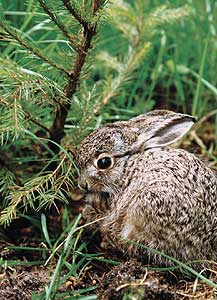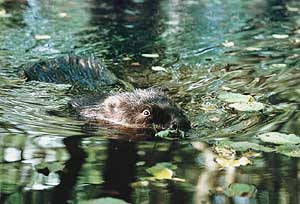|
MAMMALS
|
|||||||||||||
Text:
|
Overview
Mammals are a vertebrate group which due to its high level of organisation can adapt to living in various habitats. They live on the land surface and under it, in the open and in the thickest forests and bushes, in the sea or fresh water, in the air, in marshes and deserts, and in the mountains at considerably higher altitudes than the upper limits of plant life.
In the evolutionary development, the mammals are the group with the best developed central nervous system. The high level of brain development makes all nervous reactions in mammals much more distinctly expressed that in other animals, and their senses are very effective. Excellently developed hearing and smell senses enable searching for food, defence against enemies and finding a mate in the reproductive period.
Another important feature of mammalian physiology is homoiothermy. It is a result of the operation of internal thermoregulation which permits the maintenance of a constant body temperature independently from ambient temperatures. Thermoregulation is based on the balance between the amount of heat generated in the organism by metabolic processes and the amount of heat released to the environment. Thermal insulation of the organism from the environment plays a vital role in thermoregulation: the insulation system includes subcutaneous fat tissue and fur cover. The fur, one of the most typical mammalian features, has various forms, depending on the environment in which the animal lives. The otter, for example, has a thick and soft woollen fur which is an insulation layer, while the wild boar has a coat of thinly scattered bristles. There is tactile hair on the fox muzzle which form the sense organs. The hedgehog’s coat is particularly distinctive: its hair has become transformed into spines.
In mammals the epidermis produces various protective structures such as nails, hoofs, scales or claws. There are sebaceous glands in the skin: their secretion lubricates the epidermis and hair. In most mammals there are sweat glands which play an important role in the thermoregulation processes.
The long-term connection between the embryo and its mother is another important mammalian feature. In most mammals embryos develop for a relatively long time within the mother and born at quite an advanced stage of development. In the first developmental stage the young are fed on milk produced by the mother in mammary glands. Later, the young start searching for food in the environment in which they live. The incisors serve for cutting, canine teeth – to hold prey or meat, two premolars and molar teeth for crushing and grinding.
Mammals show high physiological flexibility and distinct morphological diversification related to their life style. The extent of morphological adjustments vary, they may include the whole organism or its part, or a single organ. In most cases adaptations to specific living conditions are specialised and they limit the ability of the animal to live in other environments. For example, the European beaver spends a part of its life in the aquatic environment: although it can move on the land, it is less agile than typical terrestrial mammals. The shortened limbs, spindle-like body shape, digits connected by a membrane, which increases the area of the rear limbs, facilitate swimming, but they reduce their ability to move on land.
The terrestrial mammals show a much more diversification of the body in comparison with mammals living in land-aquatic environments. Most running mammals are herbivorous animals and are completely defenceless when attacked. Escape is the only form of defence. The roe deer has a chance to survive only thanks to long, muscular limbs, an efficient heart and high volume capacity of lungs. a slim body shape with a prolonged neck and a relatively small head favours fast running. Thanks to its shortened upper limbs the hare has more or less vertical posture, which is useful when observing the surroundings in the open. A similar arrangement occurs in the squirrel, and it can live on trees thanks to its prehensile forelimbs, long tail and light weight.
Specific body structure occurs in the bats: they can fly actively thanks to a number of features, both in terms of body structure and physiological functions. The skin-like membrane between the prolonged digits of the forelimbs, the sides of the body the and forelimbs and hind limbs is the most significant adaptation for active flight. The membrane forms wings, beating 12-19 times per second. The fusion of upper vertebrae with the sternum and ribs makes the upper part of the trunk rigid and is an anatomic adaptation facilitating flying. Digging animals have completely different body structure. The mole has strongly developed limbs with very big claws. The muscles of the head and forelimbs are very strong to meet the requirements for digging tunnels. The hair does not have a specific ”lie” and does not block forward or backward movement. The heart of the mole is very large due to considerable work rate and short oxygen supply.
Apart from adaptations to moving related to the living environment, mammals show a number of adjustments to the type of the food they eat. In the most general terms the mammals can be divided into: carnivores, insectivores, omnivores and herbivores. The teeth and the structure of the alimentary tract are adapted to the type of food. Herbivorous animals are the most numerous mammalian group. Because plant food is absorbed poorly, the digestive tract of herbivorous animals is very long, the stomach usually has a complex structure and consists of four parts: the rumen, reticulum, omasum, and the abomasum. Carnivores have an uncomplicated alimentary tract with simple stomach to process easily digestible meat. Insect-eating mammals have more trouble with feeding because their prey is covered with indigestible chitin. They also have the largest daily food demand. The water-shrew eats so much larvae as it weighs per day. Among mammals, omnivores form the largest group.
|
||||||||||||
|
|
|




